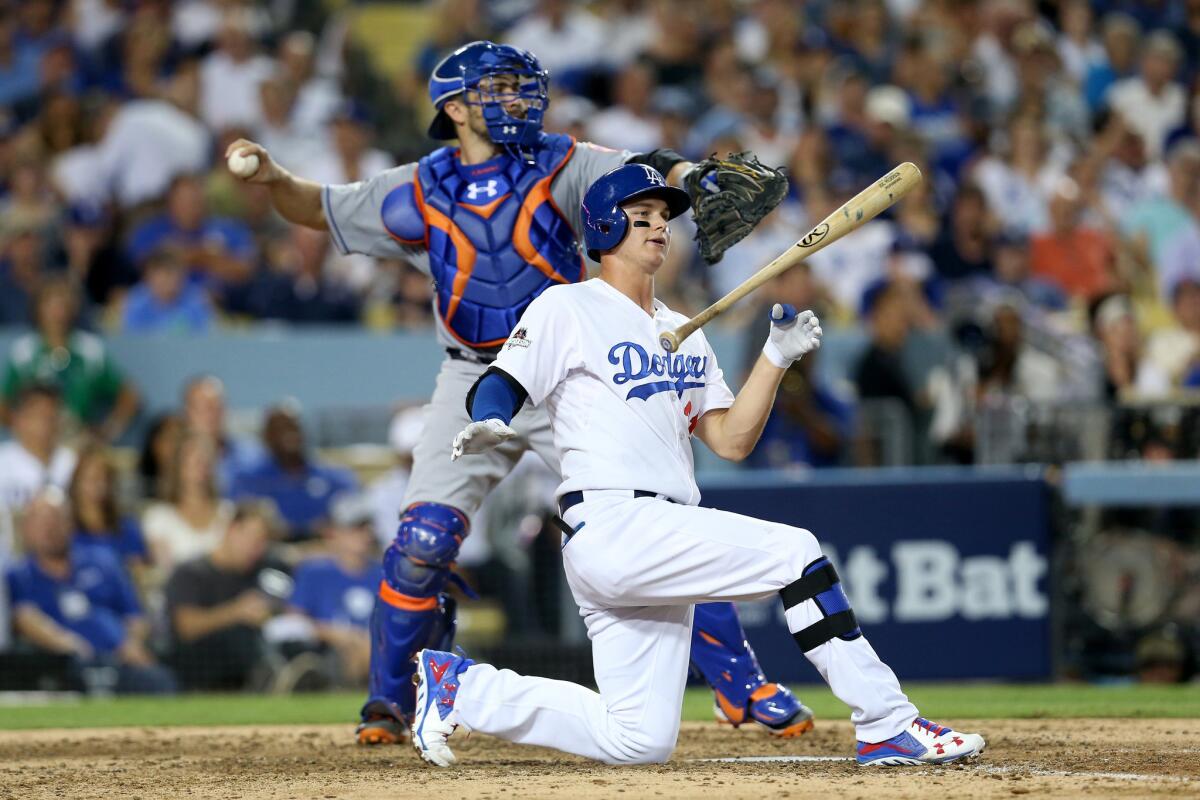Dodgers’ Joc Pederson aims to make baseball a contact sport again after second-half struggles last year

Dodgers outfielder Joc Pederson reacts after striking out against the New York Mets in the playoffs.
- Share via
Joc Pederson does not want this to sound complicated.
“I’m just trying to hit the ball hard,” he said inside the clubhouse at Dodger Stadium, a weekend away from his sophomore season as the team’s center fielder. “Put the ball on the barrel. Gotta strike out less.”
These are all noble goals, ones that the Dodgers will study with great interest as the 2016 season begins. The team spent little on free-agent hitters over the winter. Instead they chose to rely on revivals from players like Yasiel Puig, Yasmani Grandal and Pederson.
In 2015, his first full season in the majors, Pederson completed one of the most polarizing seasons in recent memory. He was an All-Star in the first half and an offensive liability in the second. He bashed 20 homers before the break and finished second in the home run derby. Upon his return from the midsummer showcase, he fell apart.
When Dave Roberts interviewed for the Dodgers’ managerial opening this winter, members of the front office asked how he would have handled Pederson’s case. He told his prospective employers he would have recommended a demotion. The Dodgers can only hope their decision to stick with Pederson will lead to a more consistent campaign in 2016.
In the winter, Pederson sought to shave the extraneous movement from his swing. In the spring, he huddled with new hitting coach Turner Ward to sharpen his daily routine. This coming summer will determine whether he can learn how to counter the pitchers who solved him last season.
“I made some adjustments, and I like where I’m at,” Pederson said.
A survey of rival talent evaluators who saw Pederson this spring raised doubt. He hit .288 in 21 exhibition games, but struck out in 40% of his at-bats. Scouts continue to question his ability to adapt. A lack of deftness in that area doomed him last season.
“Those hot-zones things that they were putting on ESPN’s ‘Baseball Tonight’ when he was hitting all those home runs? The other pitchers had those, too,” one National League evaluator said. “And they stopped throwing it there, and he got himself out a little more often.”
Pederson struggled to handle inside pitches or those in the upper third of the strike zone. Pitchers stopped feeding him fastballs over the middle, where he could extend his arms and unleash his power.
His collapse manifested in a curious way. Pederson did not become more prone to strikeouts. He punched out in more than 25% of his at-bats even at triple A in 2014, and in the second half of 2015, his strikeout-to-walk ratio mirrored his ratio from the first half. But he ceased making solid contact.
Pederson ranked 10th in the majors in the first half with a .257 isolated slugging percentage, which calculates a player’s ability to produce extra-base hits. That number fell to .122 in the second half.
His hitting coach was Mark McGwire, now the bench coach in San Diego. In his new role, competing against the Dodgers within the same division, McGwire felt uncomfortable discussing Pederson’s case at length.
“Any hitter has to make adjustments year to year,” McGwire said. “That’s just the way it is. I did. The best players in the game did. When all is said and done, this game as a hitter, it’s all about the strike zone. Understanding your strike zone.”
He added, “I love the kid. I wish him well. I truly believe he’ll bounce back. I truly believe that. That’s how much I believe in him.”
In January, Pederson called his longtime minor league coach Johnny Washington. He has hit with Washington in the past few off-seasons, and Washington threw to him during the home run derby. They met in Pasadena to prepare for this season.
As a prospect, Pederson impressed Washington with the utility of his hands. They were quick and forceful, capable of launching baseballs a prodigious distance. He did not require a sizable leg kick to generate power.
“Get the body in the position so that the hands do the rest of the work,” said Washington, now a hitting coach for San Diego’s double-A affiliate. “Take the body out of the swing. If you watch the video, there’s a lot of body in last year’s second-half swing. There was a lot of body involved. You watch good, good hitters, they’re using their hands a little bit more.”
Pederson also ventured to Dodger Stadium to meet Ward, who counseled him on the value of time management and developing a reliable, repeatable daily routine. He emphasized the importance of studying opponents and thinking ahead. In Ward’s view, a consistent approach stems from consistent habits.
“That’s what I really like to focus on with all hitters,” Ward said. “Hey, what’s your plan? What’s your approach? Doing different stuff for different pitchers. Not doing the same old, same old for every guy. Learning from the day before, too. Like, ‘How would you face him next time?’ All those things are part of the learning process.”
The latest round of tests starts Monday in San Diego. Pederson elevated expectations to a spectacular level in the first four months of 2015, then cast doubt upon his future with his performance during the rest of the season. Those who know him well still believe.
“When you have raw talent like that, your career isn’t made in half a season,” McGwire said. “He’s got 15 years, or more, if he wants to play.”
Twitter: @McCulloughTimes
More to Read
Are you a true-blue fan?
Get our Dodgers Dugout newsletter for insights, news and much more.
You may occasionally receive promotional content from the Los Angeles Times.









